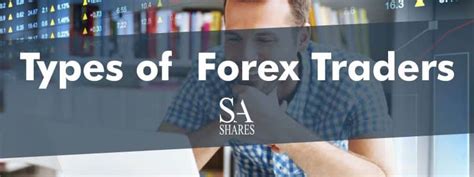
Different Type of Forex Traders: A Comprehensive Guide

Introduction
Greetings, readers! Welcome to our in-depth exploration of the diverse world of forex traders. The foreign exchange (forex) market attracts individuals from all walks of life, each with unique trading styles and objectives. In this article, we will delve into the different types of forex traders, examining their distinct approaches, risk appetites, and strategies. Join us as we uncover the complexities of these market participants, from the seasoned veterans to the aspiring beginners.
Types of Forex Traders
Scalpers
Scalpers are traders who aim to capture small profits from rapid fluctuations in currency prices. They typically hold positions for a few seconds to minutes, exploiting market inefficiencies and short-term movements. Scalpers rely on high volumes of trades and tight risk management to generate consistent income.
Day Traders
Day traders enter and exit trades within a single trading day, holding positions for several hours at most. They analyze intraday market trends and use technical analysis to identify potential trading opportunities. Day traders leverage market volatility to maximize profits within a short period.
Swing Traders
Swing traders hold positions for days or weeks, targeting larger price swings in the market. They analyze longer-term market cycles and identify areas of support and resistance. Swing traders have a higher risk tolerance than scalpers and day traders, as they aim for more substantial profits by holding positions for extended periods.
Position Traders
Position traders hold positions for months or even years, betting on long-term market trends. They have a strategic outlook and conduct extensive fundamental analysis, studying economic indicators, geopolitical events, and industry forecasts. Position traders are primarily motivated by capital appreciation and are less concerned with short-term fluctuations.
News Traders
News traders capitalize on price movements triggered by breaking news events and economic announcements. They monitor news feeds and react quickly to market reactions, attempting to predict how currency prices will respond to important events. News traders require excellent market awareness, a keen eye for detail, and the ability to make rapid decisions under pressure.
Robot Traders
Robot traders use automated trading systems to execute trades based on predetermined rules and algorithms. These systems are programmed to monitor market conditions, identify trading opportunities, and place orders without human intervention. Robot traders offer the potential for 24/7 trading, reducing emotional biases and allowing traders to focus on other aspects of their lives.
Risk Tolerance and Trading Strategies
The different types of forex traders have varying levels of risk tolerance and employ distinct trading strategies. Scalpers and day traders typically have a higher risk tolerance, as they aim for quick profits within short time frames. They use high leverage and focus on managing risk through stop-loss orders and technical analysis.
Swing traders and position traders have a more moderate risk tolerance. They typically use lower leverage and focus on identifying and capturing longer-term market trends. They conduct thorough research and employ a wider range of trading strategies, including trend following and news analysis.
Trading Experience and Market Knowledge
The different types of forex traders also have varying levels of trading experience and market knowledge. Scalpers and day traders often have extensive trading experience and a deep understanding of technical analysis. They are constantly monitoring live market data and adjusting their trading strategies based on market conditions.
Swing traders and position traders may have less trading experience but have a strong foundation in fundamental analysis. They spend more time studying economic indicators, geopolitical events, and industry forecasts to identify long-term market trends.
Table: Summary of Different Forex Trader Types
| Type of Trader | Holding Period | Risk Tolerance | Trading Strategy |
|---|---|---|---|
| Scalper | Seconds to minutes | High | Technical analysis, market inefficiencies |
| Day Trader | Hours | Moderate | Technical analysis, intraday market trends |
| Swing Trader | Days to weeks | Moderate | Trend following, support and resistance |
| Position Trader | Months to years | Low | Fundamental analysis, long-term market trends |
| News Trader | Minutes to hours | Moderate | News analysis, quick reaction |
| Robot Trader | Automated | Varies | Predefined rules, algorithms |
Conclusion
The forex market is a vast and diverse landscape, attracting traders of all types. From scalpers who seek immediate profits to position traders who aim for long-term capital appreciation, each type of forex trader has unique characteristics, risk tolerances, and trading strategies. Understanding the different types of forex traders can help aspiring traders identify their own preferences and develop a trading plan that aligns with their goals and risk appetite.
Dear readers, if you found this article informative, we encourage you to explore our other resources on forex trading. We cover a wide range of topics, including trading strategies, risk management, and market analysis. By continuing to expand your knowledge and understanding, you can unlock the full potential of the forex market and embark on your trading journey with confidence.
FAQ about Different Types of Forex Traders
What is a Scalper?
Scalpers hold positions for a brief period, usually within a few minutes to hours, and aim for small, quick profits.
What is a Day Trader?
Day traders close all their positions before the market closes, seeking to profit from short-term price fluctuations.
What is a News Trader?
News traders utilize economic or financial news, events, or announcements to predict market movements and make trades based on them.
What is a Range Trader?
Range traders identify a specific price range and focus on trading within that range, targeting profits from repeated bounces between the support and resistance levels.
What is a Trend Follower?
Trend followers ride the wave of established market trends, buying when the market is bullish and selling when bearish.
What is a Contrarian Trader?
Contrarian traders bet against the prevailing trend, assuming the market will reverse its direction.
What is a Value Trader?
Value traders buy underpriced currencies and sell overpriced ones, aiming to profit from the expected correction in their valuations.
What is an Arbitrage Trader?
Arbitrage traders exploit discrepancies in prices across different markets, buying and selling simultaneously to generate risk-free profits.
What is a Carry Trader?
Carry traders borrow currencies with low interest rates and invest them in currencies with higher interest rates, earning a positive "carry" from the difference in rates.
What is a High-Frequency Trader (HFT)?
HFTs use sophisticated algorithms and high-speed computers to trade rapidly and often on extremely short time frames.

